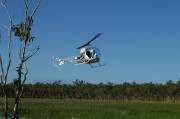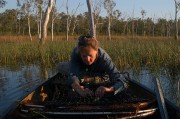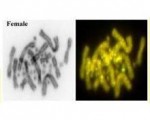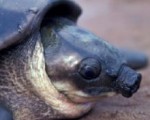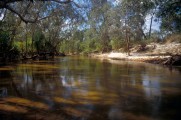Charles Darwin, ca January 1849
A Brief History
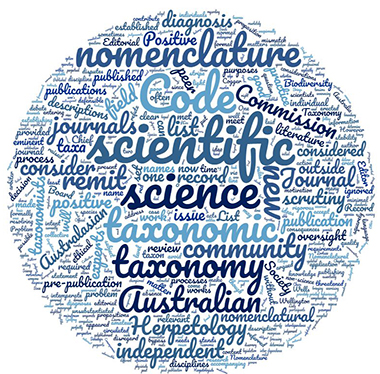
Herpetological taxonomy in Australia is in turmoil. It has been since Wells and Wellington produced and circulated their document entitled a classification of the Amphibia and Reptilia of Australia in the Australian Journal of Herpetology. In this article, they bypassed the time honoured process of scientific publication that includes independent pre-publication scrutiny by eminent experts in the field under the oversight of a suitably qualified Chief Editor and Editorial Board. Sweeping changes were made to the taxonomy of Australian reptiles and frogs. Since then, the journals Australian Biodiversity Record and the Australasian Journal of Herpetology have appeared with a similar goal, to put names to as many elements of our reptile and amphibian biodiversity as possible.
In the furore that followed, and continues to this day, most affected taxonomists were incensed by the blatant disregard for the established processes of contributing to the scientific record, by having their meticulous work reinterpreted and used to erect new taxa before they have themselves published, and by the intemperate sometimes abhorrent language that entered the debate. So heated has become the debate that lawsuits are threatened or have ensued.
The scientific inadequacy of the descriptions and diagnoses were often manifestly obvious, yet original descriptions have to be referred to forever, regardless of the paper's quality (Krell, 2002). Equally disturbing is the flight of young putative taxonomists faced with having to spend much of their time wading through not only the inadequate descriptions of times past, but also those equally poor descriptions and diagnoses we must contend with now; all with the risk that their hard work over the years can easily be gazumped by someone publishing on a "milk carton".
The circumstances are not new, as they concerned even Darwin, but they have been exacerbated by ready access to the means of publishing and disseminating material; now within reach of everyone. The impact on taxonomy is as worrying as the impact of fake news on society generally.
It is a conundrum.
The Crux of the Problem
The crux of the problem appears to be the mismatch between the remit of taxonomy (which is the domain of science) and the remit of nomenclature (governed by the International Code of Zoological Nomenclature).
- The rules of nomenclature as laid down in the Code requires only that an author purports to diagnose a new taxon; science demands that the diagnosis be defensible. A red stripe on the cheek present only in the absence of light is a perfectly good diagnosic character from a nomenclatural perspective, but not admissible by science.
- Under the Code, "It is possible, provided the rules of nomenclature and publication are met, for any person without the slightest knowledge of, or interest in, a group of animals to validly describe as many species as he or she likes" (Cogger 2018:4). Science in contrast would expect some level of knowledge, capability and commitment to the scientific method to mount a defensible case for the existence of a new taxon.
- Contributions to science are typically made via the time-honoured process of rigorous and independent pre-publication scrutiny by experts in the field, with the oversight of a Chief Editor and an Editorial Board comprised of eminent scientists in the relevant field. An author is expected to formally expose their ideas to refutation before it is published and accepted into the scientific record. No such requirement is placed on authors by the Code, which admits magazines, newsletters, and self-published works, provided only that the conditions laid down by Code are met. What is and is not valid publication for scientific as opposed to nomenclatural purposes is a major bone of contention.

In adopting rigorous and independent pre-publication scrutiny by experts in the field, the scientific process recognises a tipping point. Before a proposition is published, Bertrand Russell's teapot principle applies -- the onus is on the authors to convince the peer reviewers that their proposition is supported by evidence or sound argument. Once published, the onus is reversed. To overturn a published proposition, it is up to other researchers to mount argument and present evidence that the proposition is false, or that an alternate proposition is better supported. Not so in taxonomy. Enthusiastic Code aficionados often argue vehemently that the onus is on those who wish to refute a taxonomic hypothesis, whether or not it has been subjected to formal pre-publication defense. Once published, and wherever it may have been published, opponents need to mount and publish the counter case before the proposition can be discounted. In taxonomy, where peer review is optional, Russell's teapot exists until proven otherwise from the get-go.
In my view, these sources of tension are at the heart of the difficulties we are facing in taxonomy in the 21st century. The root of the problem is not about the motivation of particular individuals, their intemperate language, or their disregard for the non-mandatory Code of Ethics set out in the Code. The root of the problem is that we admit non-science into the remit of taxonomic science, then compel taxonomists to consider it.
No other discipline of science does this.
It has been argued that new taxonomic arrangements, including the erection of new taxa, can be rejected or ignored by any taxonomist who regards them as incorrect or poorly supported. The names however, cannot cannot be ignored, and come under the purview of the Code. By this view, the two -- taxonomy and nomenclature -- are considered independent considerations.
The application of the Code and the rules of nomenclature should not impinge on science used to discover new taxa. The two need to be at arm's length. But that is not to say they are completely independent. They are inter-dependent. One cannot name a taxon without a description and diagnosis. How is one to ignore or reject the taxonomy and accept the name (as a junior synonym) without considering the adequacy of the accompanying diagnosis? It cannot be done. In compelling taxonomists to accept a new name erected under the loose provisions of the Code, it is forcing taxonomists to consider in detail the accompanying diagnosis and description even though they have been published, often with scant attention to defensible evidence, through channels outside the remit of science.
The consequences of this mismatch between the remit of science and the remit of nomenclature are profound and destructive. Unlike any other scientific discipline, those engaging in taxonomy are required to wade through often extensive and contemporary unsubstantiated information that has not been subject to adequate independent prepublication scrutiny by experts in the field under appropriate editorial oversight. Taxonomists cannot avoid a fundamental asymmetry (sometimes referred to as Brandolini's law) – it is easy to erect unsubstantiated and often irrefutable propositions outside the mainstream peer reviewed scientific literature; immense effort and cost is required to refute those propositions by those adhering to the principles and practice of good science. The scientific refutation of unsubstantiated claims promulgated outside the normal avenues of scientific discourse can be incredibly arduous, costly and, as Darwin noted, disheartening.
To summarize the argument so far, the Code is immensely valuable to science, providing stability of nomenclature and a basis for unambiguous communication. However, the system as it now stands is vulnerable. The gentlemanly etiquette that served us so well under the umbrella of the Code has been effectively dismantled, at least for herpetology, by a few recalcitrant individuals who adhere to the word but not the spirit of the Code. No code of conduct, or indeed contract, can withstand a concerted assault by those not committed to its fundamental intent. Chaos reigns with the resultant taxonomic churn and uncertainty delivering greater stability to common names than scientific names.
A Problem for Nomenclature or for Taxonomy?
The problem is seen as one for science not nomenclature. While the International Commission on Zoological Nomenclature is an arbiter in nomenclature, it sees no role in resolving taxonomic disputes. The Commission stands steadfastly behind its principle of not intruding on matters of taxonomic science. This was made clear in the Commission's determination of the Wells and Wellington case, where it indicated that the problem was one mainly of a taxonomic nature rather than nomenclature, resulting from primarily poor scientific and editorial practice. They threw the issue back to the scientific community. They did the same in essence with the more recent case regarding the Australasian Journal of Herpetology. The Commission found no reason to consider the Australasian Journal of Herpetology as being unpublished in the sense of the Code.
The issue may well be one for taxonomic science to resolve, but currently there is no arbiter in taxonomy beyond the peer review process by individual journals or by subsequent usage (Cogger et al., 2017). Nor is the issue conducive to individual action as it is in other disciplines. A privately-printed and circulated newsletter by an amateur physics bod announcing the discovery of perpetual motion will be resolutely ignored by physicists. Not so in taxonomy as I have argued. Collective action is clearly needed, but what form should it take?
A number of options have been raised to provide arbitration in resolving taxonomic disputes, ranging from loose collective individual action to formal collective action.
A Positive List
The idea presented here, and championed by the Australian Society of Herpetologists in formulating its List of Species of Amphibian and Reptile, is that we as a professional scientific community, bring the remit of science and the remit of nomenclature together by establishing a positive list of journals (and other relevant publications) in which taxonomic work must appear if it is to be considered to contribute to the scientific record. This idea is not new.
The advantages of such a positive list are that it
- Places the issue and its resolution where it should be, with the scientific community, and not with the Commission or the Code.
- Removes the onus on the scientific community to establish new adjudicating entities to make judgements on the content of articles in which new taxa are erected and places it squarely where it belongs, with scientific peer review.
- Sidesteps considerations of ethical practice by those seeking to bypass the scientific process and bypass the ethical standards that normally govern scientific research, by focussing squarely on the science. We avoid entering the hoary space of judging the motivation, malicious intent, or taxonomic vandalism of those operating under a different ethical framework from that of science. If it is good science acceptable to a journal on the positive list, then motivational and behavioural issues can be set aside.
- Leaves open to all the option of publishing their research and syntheses provided the basic level of independent pre-publication scrutiny by experts in the field (peer review) is reached, by publication in a journal or monograph subject to such rigorous peer review (e.g. Zootaxa, a museum journal, or other journals as determined by the Society). This is not censorship.
- Sends a clear signal to those who operate outside the norms of scientific practice in naming new taxa (and other nomenclatural acts) that their activities will not deliver for them. The scientific community will not be obliged to address their documents.
- Brings the science of taxonomy into line with other scientific disciplines, where participants in the science are not required to address and formally consider or refute matters raised outside the scientific literature. They may choose to do so, but they are not obliged to do so.
To clarify the application of a positive list, consider the question put to the Commission:
"Do the journals Australasian Journal of Herpetology and Australian Biodiversity Record unequivocally meet or not meet the publication criteria, for nomenclatural purposes, set out in Chapter 3 of the Code?"
This may well be a matter for the commission, but it does not address the central issue of concern. The question at the core of the issue is one for the scientific community. The question becomes:
"Have these journals met the minimal requirements to be considered to have made a contribution to the scientific record".
There are arbiters already in place. We might ask, has the journal been accepted into the Web of Science Core Collection, based on transparent criteria, administered by an entity at arms length from the publishing houses and responsive to changes in the publishing landscape? Does the journal have in place the normal processes of independent pre-publication scrutiny by eminent experts in the field with the oversight of a qualified Chief Editor and Editorial Board? These are questions for the scientific community, for taxonomy, not for nomenclature. If they do not meet these minimal requirements, then we as practicing scientists (professional and amateur) have no obligation to consider them. That is the value of a positive list.
Nomenclatural Consequences Follow
One might argue that the question posed for the scientific community above is legitimate and one within their power to decide. However, nomenclatural consequences follow from what is essentially a taxonomic decision. The establishment of a Positive List recognises the inter-dependence of nomenclature and taxonomy, by attempting to bring the remit of each into line. Under this proposition, published works considered publications for the purposes of nomenclature and publications considered to contribute to the scientific record are one and the same set. The tensions listed above evaporate.
This means though that nomenclatural acts published outside the established scientific literature (in journals not on the Positive List) may be disregarded in the disciplines that choose to adopt a such a positive list. This is clear from the Kaiser proposal, the position statement of Taxonomy Australia, and the initial and updated position statement of the Australian Society of Herpetologists.
In our case, gone would be the Australian Journal of Herpetology, the Australian Biodiversity Record, the Australasian Journal of Herpetology, Reptile Magazine and the Batagur Monographs (albeit post Jan 1, 2000) in terms of all the complexities that have come with the compulsion to consider their content. The decision of what is science and what is not rests with the scientific community, now able to excercise the normal checks and balances on the quality of ideas and information entering the scientific record.
It will not be plain sailing, as some of the taxonomy and nomenclature introduced through channels outside the mainstream literature could subsequently be "legitimized" in a scientific publication. Such a case presented itself recently over the legitimacy of Elseya lavarackorum. Had Elseya oneiros stood as a defensible taxon (see the 2023 article in Vertebrate Zoology), what to be done with the original naming in the Batagur monographs? These sort of actions will present some nomenclatural challenges that will have to be worked through.
Also, the processes of scientific publication are not perfect. If a diagnosis resting on the presence of a red stripe only present in the absence of light slips through, we have to live with it and deal with the proposition via the formal processes of post-publication scrutiny and rebuttal. This is what happened with the "hand of God" explanation that appeared in PLoS One 2016, or the new weird goblin shark published in Mediterranean Marine Science, both since retracted.
Is the Commission off the Hook?
The Commission and those who are strict adherents to the Code are likely to be deeply uncomfortable about having the Code apply only to the scientific literature as defined by various peak professional societies.
Hopefully, the Commission will come to see that they need to act in the interests of maintaining their constituency within the scientific community. After all, the Code enables the Principle of Priority to be set aside on occasions when its application would be destructive of stability or universality, or would cause confusion. As the late W.D.L Ride said in his introduction to the most recent iteration of the Code, "both science itself and the social and technical systems within which scientists work are constantly changing, and the Code must continue to evolve to provide for these changes. Zoologists may remain confident that it will do so". Are we confident? Taxonomy Australia has called upon the Commission to find appropriate solutions to the issues we face, solutions supported by the zoological community.
I do not have the solution for the Commission. Perhaps there is a way to legitimize, under the Code, the ability of peak scientific communities to each determine the boundary between science and non-science (exercising scientific judgement) by establishing Positive Lists. Such a decision is at the cutting edge of the inter-dependence of the Code and Taxonomy, and allows the Code to continue with its good work as it applies to the scientific literature. The alternative I feel is the inevitable establishment of a dual taxonomy, one for the strict adherents of the Code (applying even to magazines) and the other for those disaffected individuals who follow the lead of Kaiser, Taxonomy Australia and the Australian Society of Herpetologists. One can argue that a dual taxonomy is already the status quo for Australian herpetology, a very unfortunate turn of events.
Are we Denigrating our Detractors?
Does the Positive List, and its requirement to publish through scientific channels, discriminate against the amateur taxonomist (one who engages on an unpaid rather than a professional basis)? Many professional taxonomists are wary of doing anything that might deter amateur contributions. With so many species left to discover, and with existential threats to biodiversity looming, they realize the field needs as much help as it can get. There is no doubt that a meticulous amateur can be way more capable in their particular area of expertise than many a professional taxonomist. The question at hand is whether their contribution meets the minimum standards required for engagement in the scientific process. It is not about whether a person is operating as an amateur or a professional, but whether or not the contribution is of an acceptable standard. In some circumstances, amateur taxonomists could be mentored and associated with professional or eminent amateur taxonomists, museums or academic institutions. Meeting the minimal standards of a contribution to the scientific record is not a big ask.
A second concern is that proponents of the Positive List are placing molecular evidence above morphological evidence in assessing the quality of a contribution. This is fundamentally not the case, but is perceived to be the case because molecular systematics has moved forward in leaps and bounds as new technologies have arisen, whereas the counterbalancing morphological analyses have not been (in the case of Australian turtles at least) moving with the times to use the best available techniques and analysis tools. Times have moved on in the morphological area as well, both in the techniques for 3D scanning and in statistical analysis. There is no fundamental reason why morphology cannot stand head to head with molecules as equal complementary partners in the 2ist century. Unfortunately, it is often currently a no contest.
At the very least, given that it is not essential to use the latest technologies to describe new taxa, there are some minimum expectations, a somewhat moving feast honed by the process of scientific peer review. Those minimum, very basic, expectations are often not met by those electing to present their findings outside the mainstream peer reviewed literature.
Eutopia Beckons
I say Eutopia Beckons somewhat tongue in cheek. There are many impediments to taxonomy. The rampant proliferation of species names with little or no evidence to establish the taxa to which they apply, is but one. In an attempt to address this, we in Australia now have taken a clear position on so-called Taxonomic Vandalism, established a Positive List (for journals and other relevant publications) and come to consensus on an "official" List of Species of Australian Amphibians and Reptiles. This official list has been adopted by the herpetological community (represented by ASH). It has now been adopted by the government agency responsible for crafting legislation and regulation, via the Australian Faunal Directory, which flows through to the listing of threatened and endangered species. A similar approach has been adopted by the Australian Mammal Society.
If the Positive List and the Official List of Australian Amphibians and Reptiles is widely adopted, this could put an end to the dual taxonomy in Australian herpetology and herald an era of relatively stable nomenclature.
Let's see how this pans out.
Disclaimer: The views outlined above are mine and not necessarily those of the Australian Society of Herpetologists.
Arthur Georges













